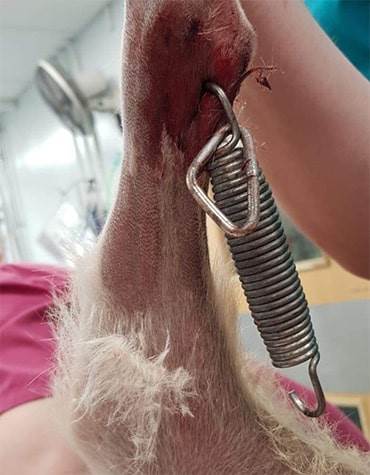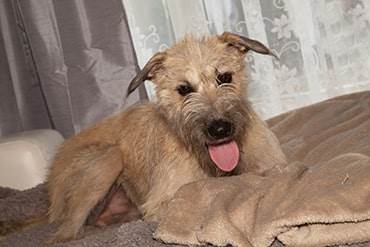Dog left with a nasty spring in his step
20 June 2019
Bruce saved by PDSA after horrific trampoline accident.
Poor Bruce was left with a trampoline spring impaled into his leg, following a shocking accident. Thankfully, after emergency surgery at PDSA, he’s now on the mend and expected to make a full recovery.
Ten-month-old Bruce has been with the Black family since he was ten weeks old, and is an important and much-loved member of the family. So they were horrified when a terrible accident left Bruce with an alarming injury, and at risk of losing his leg.
His owner Natasha Black (46) from, Shoeburyness, Essex, described what happened: “Bruce had been playing on the trampoline with my daughter Jessie (13), but when he went to get off I heard a terrible cry – his leg had got caught in one of the springs at the side. I quickly ran over and realised that not only had the metal spring gone right into his leg, it was still attached to the trampoline and he couldn’t get loose. It was horrific and Bruce was crying in pain.
“Thankfully my neighbour heard the noise and rushed over to help. While I tried to keep Bruce calm and still, he cut the spring free from the trampoline so we could get him to the vet.”
Shocked and distraught, Natasha rushed Bruce to the Basildon PDSA Pet Hospital, The Coco Markus Centre, where he was rushed into theatre. PDSA Senior Vet at Basildon PDSA, Gareth Dowdeswell, explained: “The spring had pierced quite deeply into Bruce’s leg. We gave him pain relief immediately to make him more comfortable and calm. Amazingly, despite his distress, Bruce was still wagging his tail when he met us!
“Bruce needed a general anaesthetic to assess the injury fully and to confirm the extent of the damage. So it was ‘all hands on deck’ as we planned and prepped Bruce for a full examination, and for surgery to remove the spring.”
It was a worrying wait for Natasha and her family who had been warned that, depending on the extent of the injury, the worst case scenario could be amputation if there was permanent nerve damage. However, the dedicated team of vets and nurses at PDSA were determined to do everything they could to save Bruce’s leg.
Gareth added: “On close examination, we could see the spring had hooked through a gap behind his Achilles tendon. If it had been just a few centimetres in another direction the spring could have caused a fracture, major bleeding or even permanent damage to nerves and tendons.
“However, as we proceeded with the operation, it became clear that Bruce was a very lucky dog – there were no broken bones, or nerve damage. But it was still a delicate procedure to remove the spring without causing further damage. Bruce was extremely fortunate not to have done himself more damage or even lost the leg.”
A few hours later, the Black family received a very welcome call – the spring had been successfully removed and, importantly, there was no permanent damage. The wound had been cleaned and dressed, and, after a little recovery time, he was able to go home for some much-needed TLC.
Natasha said: “We were so incredibly relieved to hear he was going to be ok. Especially my daughter, who has learning difficulties and has become extremely close to Bruce. They’re best friends and he’s really helped her social skills – she takes him out for short walks now, and she talks to him constantly.”
Vet Gareth added: “Bruce is an incredibly lucky puppy! It’s still early days, but we expect him to make a full recovery.”
Natasha continued: “PDSA were amazing, I couldn’t have wished for better care. They are so friendly and helpful, and I knew Bruce was in the best hands. He’s recovering really well – his wound is almost completely healed now, and he’s wanting to bound around like crazy again. To look at him now you’d never know anything happened.”
PDSA does not recommend allowing pets to play on trampolines as, even under close supervision, accidents can easily occur.
Natasha continued: “I feel awful as I just didn’t realise the danger. We’ve taken the trampoline down now to keep everyone safe – there are plenty of other ways for my daughter and Bruce to play and have fun together.”
PDSA started a fundraising campaign to raise money to help cover the cost of Bruce’s treatment and other pets like him. It reached the target of £200 in less than an hour, and all further donations will help PDSA to treat other pets like Bruce in need of urgent care.
Every year, the dedicated teams at PDSA’s 48 Pet Hospitals work tirelessly to provide 2.7 million veterinary treatments. This includes emergency operations like Bruce’s, as well as routine preventive care such as neutering and vaccinations.


Post-surgery care
Has your pet recently had an operation? We have information, written by vets, on the steps you should take after your pet's operation.
